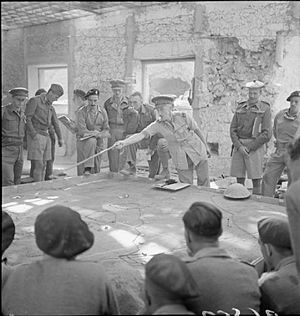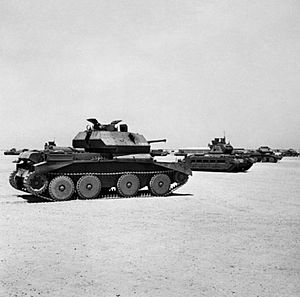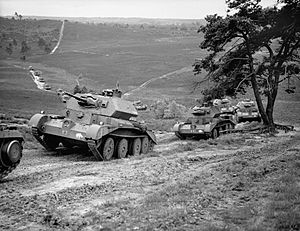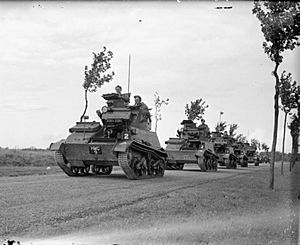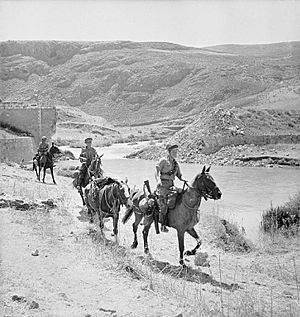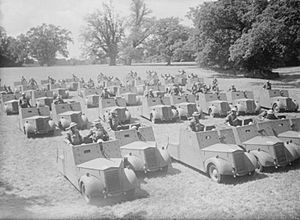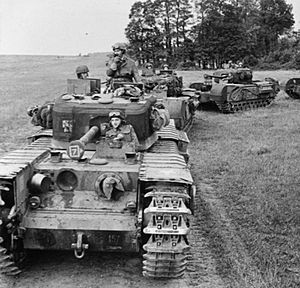List of British mobile brigades during the Second World War facts for kids
During World War II, the British Army had many special groups called brigades. These brigades were not just regular infantry (foot soldiers). Instead, they used machines, vehicles, or even horses to move around. Each brigade had several battalions or regiments and was led by a brigadier.
A brigade could be part of a larger group called a division. Or, it could work on its own, reporting to a corps headquarters or even higher command. When the war started in September 1939, Britain had seven armoured brigades. They also had five tank brigades and one support group. Many more of these brigades were created, renamed, or stopped existing during the war.
At first, the names of units in brigades were a bit confusing. An armoured brigade was the main fighting force in an armoured division. It used fast cruiser tanks. These tanks were meant to find and use gaps in enemy lines. They also fought against enemy tanks. These brigades also had their own motorised infantry (soldiers who moved in vehicles).
Tank brigades, on the other hand, used heavy infantry tanks. These tanks were designed to help infantry divisions. They were also used to break through strong enemy defenses. But sometimes, brigades just used whatever tanks were available. In May 1940, the names of units became more standard. All tank units were called "regiments" instead of "battalions." By 1945, all tank brigades were renamed armoured brigades. This removed the difference between the two types.
Contents
- How British Tank Brigades Were Formed
- Armoured Brigades: Fast and Powerful
- Armoured Reconnaissance Brigades: Scouting Ahead
- Cavalry Brigades: From Horses to Motors
- Motor Machine Gun Brigades: Making Do with What They Had
- Support Groups: Helping the Armoured Divisions
- Tank Brigades: Supporting the Foot Soldiers
- See also
How British Tank Brigades Were Formed
By the 1930s, the British Army had decided they needed four main types of tanks. These were the light, medium, cruiser, and infantry tank. Each tank type had a different job. The idea for medium tanks was later combined with cruiser tanks. This difference in tank types decided how brigades were named and what their job would be. Armoured brigades used cruiser tanks. Tank brigades used infantry tanks. No matter the type, a brigadier always led the brigade.
British tank rules said that brigades with infantry tanks would help infantry (foot soldiers). They would break through the enemy's defensive lines. Brigades with cruiser tanks would then rush through any holes created. Light tanks were used for scouting ahead. In the 1930s, British tanks mostly had machine guns. Cruiser tanks were supposed to be faster than infantry tanks. They also had more armor and an anti-tank gun. Besides breaking through enemy lines, cruisers were meant to destroy enemy tanks. Infantry tanks had the heaviest armor. They were slower and worked closely with foot soldiers.
At the start of World War II in 1939, regiments of mechanized cavalry (soldiers on horseback, but now in vehicles) were meant for armoured brigades. They would use cruiser tanks. The battalions of the Royal Tank Regiment were for tank brigades. They would use infantry tanks. In May 1940, the Royal Armoured Corps (the main group for all tank units) made names more consistent. The word "battalion" was dropped. All Royal Tank Regiment units became "regiments." Usually, a brigade had three battalions or regiments. In 1945, another change happened. All tank brigades were renamed armoured brigades.
But things didn't always go as planned in real battles. For example, in 1940, the 1st Armoured Brigade had a mix of cavalry and Royal Tank Regiment units. They used both cruiser and light tanks. In 1941, parts of the 3rd Armoured Brigade even used captured Italian M13/40 medium tanks. This was because Britain didn't have enough of its own tanks.
Later, lend-Lease from the US brought American tanks. The 4th Armoured Brigade got American M3 Stuart light tanks. These tanks had a machine gun and an anti-tank cannon. In 1942, the 23rd Armoured Brigade used Valentine infantry tanks. The 9th Armoured Brigade had a mix of cruiser and American medium tanks.
By mid-1944, most armoured brigades used the American M4 Sherman tank. This was because Britain couldn't make enough of its own cruiser tanks. British tanks also had some quality and reliability issues. In 1944, nine British armoured brigades went to France. Only the 22nd Armoured Brigade mainly used British tanks (the new Cromwell). But by early 1945, more British tanks were used in Europe. For example, the 29th Armoured Brigade started getting the new British Comet tank in December 1944.
In late 1944, the US also reduced tank deliveries to Britain. This was because the US Army needed more tanks for itself. By 1945, Britain realized they couldn't rely on American tanks as much anymore. They had to focus more on their own tank production.
Armoured Brigades: Fast and Powerful
An armoured brigade was the main fighting group within an armoured division. At the start of World War II, an armoured division was supposed to have two armoured brigades. One was "heavy" and one was "light." The heavy brigade was meant to have 147 'heavy cruisers,' like the Cruiser Mk II and Cruiser Mk III. The light brigade was to have 174 tanks, a mix of light tanks and 'light cruisers' like the Cruiser Mk I. Another 20 tanks were for the brigade's headquarters.
In April 1940, the "light" and "heavy" names were dropped. Each brigade was then supposed to have three armoured regiments, with 52 tanks each. But in reality, brigades used whatever tanks were available. For example, in 1940, the 2nd Armoured Division's two brigades had 256 light tanks and 54 cruisers.
From October 1940, each armoured brigade was supposed to include a motorised infantry battalion. These soldiers would move in vehicles. For brigades in an armoured division, these battalions came from the division's support groups. But this change didn't happen everywhere at once. For example, the 2nd Armoured Division's 1st Armoured Brigade got its infantry battalion in February 1941. But its 3rd Armoured Brigade never got one. Most brigades formed after October 1940 did include the infantry battalion from the start.
As the war went on, the setup of brigades changed. This was different for brigades in the UK compared to those fighting in North Africa. By 1942, armoured divisions in North Africa had one armoured brigade that became a "brigade group." This meant it had its own support units, like engineers and artillery. American tanks arriving in Egypt also meant different equipment. UK-based brigades only had cruisers. Those in Egypt had a mix of cruisers and American light and medium tanks.
By mid-1942, the "brigade group" idea was stopped. Support units went back to being part of the division. Each brigade in the Middle East then had three regiments of 52 tanks. The brigade headquarters also got eight extra tanks. The brigade also had four tanks with anti-aircraft guns.
In 1943, armoured brigades were standardized for both those abroad and in the UK. Each brigade had three regiments of 55 cruiser/medium tanks. They also had six tanks with howitzers for close support. There were eight anti-aircraft tanks and ten tanks for the brigade headquarters. From March 1944, brigades also got 33 light tanks for reconnaissance (scouting). They also had eight tanks set up as artillery observation posts. In 1945, the brigade headquarters had only seven tanks.
Besides brigades that were part of divisions, the British Army also used independent armoured brigades. Early in the war, these could be sent to help an expeditionary force, like the 1st Armoured Brigade in the Battle of Greece. Or they could do special jobs, like the 9th Armoured Brigade at the Second Battle of El Alamein. In North Africa, these independent brigades often replaced brigades that had lost many tanks. They also reinforced divisions or gave tank support to infantry units. They were set up like the brigades in divisions.
Before the Allied invasion of France in 1944 (Operation Overlord), Britain planned to have eight tank brigades to support infantry. These brigades would be assigned to larger commands. Then, they would be given to infantry divisions as needed. But there weren't enough tanks. So, five of these brigades became independent armoured brigades. They used M4 Sherman tanks. General Bernard Montgomery, who led the 21st Army Group, wanted a "Universal Tank." This tank would combine the best parts of infantry and cruiser tanks. He felt the M4 Sherman was the closest thing. He didn't see a difference between armoured and tank brigades. He would use them as he saw fit, not just for their old roles. This flexibility allowed these armoured brigades to support infantry in new ways.
In 1943, the 79th Armoured Division was changed. Its job was to create specialized tanks for landing on the French coast. It went to France in June 1944 for Operation Overlord. It had two armoured brigades. These brigades used Churchill infantry tanks and M4 Shermans. These tanks were changed to handle obstacles during the Normandy landings and later battles. Changes included mine-clearing flails, Armoured Vehicle Royal Engineers (Churchill tanks with special weapons and bridging gear), and flamethrowers. These special units were sent where they were needed. The brigadier would advise on how to use them.
In January 1945, the British Army decided that all remaining tank brigades would be renamed armoured brigades. But they still used their infantry tanks and didn't always get new medium or cruiser tanks.
| Formation name | Existing formation or date created | Date formation ceased to exist | Locations served | Notable campaigns | Notes | Source(s) |
|---|---|---|---|---|---|---|
| 1st Armoured Brigade | Existing | 21 November 1942 | United Kingdom, Egypt, Greece, Italian-Libya | Battle of Greece, Western Desert campaign | Started as 1st Light Armoured Brigade. Renamed 1st Armoured Brigade on 14 April 1940. Disbanded in Egypt on 21 November 1942. | |
| 1st Assault Brigade Royal Engineers | 26 November 1943 | 30 July 1945 | United Kingdom, France, Belgium, Netherlands, Germany | Operation Overlord, Allied advance from Paris to the Rhine, Western Allied invasion of Germany | Formed from Engineer Assault Troops. Used specialised tanks. Disbanded in Germany on 30 July 1945. | |
| 2nd Armoured Brigade | Existing | N/A | United Kingdom, France, Egypt, Italian-Libya, Tunisia, Italy | Battle of France, Western Desert campaign, Tunisia Campaign, Italian campaign | Started as 2nd Light Armoured Brigade. Renamed 2nd Armoured Brigade on 14 April 1940. Ended the war in Italy. | |
| 3rd Armoured Brigade | Existing | 11 January 1943 | United Kingdom, France, Egypt, Italian-Libya | Western Desert campaign | Started as 1st Heavy Armoured Brigade. Renamed 3rd Armoured Brigade on 14 April 1940. Disbanded on 11 January 1943. | |
| 4th Armoured Brigade | Existing | N/A | Egypt, Italian-Libya, Tunisia, Italy, United Kingdom, France, Belgium, Netherlands, Germany | Western Desert campaign, Tunisian campaign, Allied invasion of Sicily, Italian campaign, Operation Overlord, Allied advance from Paris to the Rhine, Western Allied invasion of Germany | Started as Heavy Armoured Brigade (Egypt). Renamed 4th Armoured Brigade on 14 April 1940. Ended the war in Germany. | |
| 5th Guards Armoured Brigade | 15 September 1941 | 12 June 1945 | United Kingdom, France, Belgium, Netherlands, Germany | Operation Overlord, Allied advance from Paris to the Rhine, Operation Market Garden, Western Allied invasion of Germany | Formed from 20th Independent Infantry Brigade (Guards). Became an infantry formation on 12 June 1945. | |
| 6th Guards Armoured Brigade | 15 September 1941 | 17 June 1945 | United Kingdom, Netherlands, Germany | Allied advance from Paris to the Rhine, Western Allied invasion of Germany | Formed from 30th Independent Infantry Brigade (Guards). Became an infantry formation on 17 June 1945. | |
| 7th Armoured Brigade | Existing | N/A | Egypt, Italian-Libya, Ceylon, Burma, British India, Iraq, Palestine, Syria, Italy, Austria | Western Desert campaign, Burma Campaign, Italian campaign | Started as Light Armoured Brigade (Egypt). Renamed 7th Armoured Brigade on 14 April 1940. Ended the war in Austria. | |
| 8th Armoured Brigade | 1 August 1941 | N/A | Palestine, Egypt, Italian-Libya, Tunisia, United Kingdom, France, Belgium, Netherlands, Germany | Western Desert campaign, Operation Overlord, Allied advance from Paris to the Rhine, Western Allied invasion of Germany | Formed in Palestine from the 6th Cavalry Brigade. Ended the war in Germany. | |
| 9th Armoured Brigade | 3 August 1941 | N/A | Syria, Iraq, Iran, Palestine, Egypt, Italy, United Kingdom | Second Battle of El Alamein, Italian campaign | Formed in Syria from the 4th Cavalry Brigade. Ended the war in the United Kingdom. | |
| 10th Armoured Brigade | 1 November 1941 | 25 July 1942 | United Kingdom | did not see combat | Formed from the 125th Infantry Brigade. Renamed 10th Tank Brigade on 25 July 1942. | |
| 11th Armoured Brigade | 1 November 1941 | 25 July 1942 | United Kingdom | did not see combat | Formed from the 126th Infantry Brigade. Renamed 11th Tank Brigade on 25 July 1942. | |
| 20th Armoured Brigade | Existing | 30 April 1943 | United Kingdom | did not see combat | Started as 20th Light Armoured Brigade. Renamed 20th Armoured Brigade on 14 April 1940. Disbanded on 30 April 1943. | |
| 21st Armoured Brigade | 11 June 1945 | N/A | Italy | Italian campaign | Formed in Italy from the 21st Army Tank Brigade. Ended the war in Italy. | |
| 22nd Armoured Brigade | Existing | N/A | United Kingdom, Egypt, Italian-Libya, Tunisia, Italy, France, Belgium, Netherlands, Germany | Western Desert campaign, Italian campaign, Operation Overlord, Allied advance from Paris to the Rhine, Western Allied invasion of Germany | Started as 22nd Heavy Armoured Brigade. Renamed 22nd Armoured Brigade on 14 April 1940. Ended the war in Germany. | |
| 23rd Armoured Brigade | 1 November 1940 | N/A | United Kingdom, Egypt, Italian-Libya, Tunisia, Italy, Palestine, Greece | Western Desert campaign, Allied invasion of Sicily, Italian campaign, Operation Manna | Formed from the 23rd Army Tank Brigade. Ended the war as an armoured brigade. | |
| 24th Armoured Brigade | 1 November 1940 14 July 1944 |
1 March 1943 29 September 1944 |
United Kingdom, Egypt, Italian-Libya | Western Desert campaign | Formed from the 24th Army Tank Brigade. Disbanded in Egypt on 1 March 1943. A dummy tank brigade was later renamed 24th Armoured Brigade (Dummy Tanks). | |
| 25th Armoured Engineer Brigade Royal Engineers | 5 January 1945 | N/A | Italy | Italian campaign | Formed from the 25th Army Tank Brigade. Ended the war in Italy. | |
| 26th Armoured Brigade | 12 October 1940 | N/A | United Kingdom, Tunisia, Italy, Austria | Tunisian campaign, Italian campaign | Formed from the 1st Motor Machine Gun Brigade. Ended the war in Austria. | |
| 27th Armoured Brigade | 12 October 1940 | 30 July 1944 | United Kingdom, France, Belgium, Netherlands, Germany | Operation Overlord, Allied advance from Paris to the Rhine, Western Allied invasion of Germany | Formed from the 1st Armoured Reconnaissance Brigade. Disbanded in France on 30 July 1944. | |
| 28th Armoured Brigade | 1 December 1940 | 21 August 1944 | United Kingdom | did not see combat | Formed from the 3rd Motor Machine Gun Brigade. Disbanded on 21 August 1944. | |
| 29th Armoured Brigade | 28 December 1940 | N/A | United Kingdom, France, Belgium, Netherlands, Germany | Operation Overlord, Allied advance from Paris to the Rhine, Western Allied invasion of Germany | Assigned to the 11th Armoured Division for most of the war. Ended the war in Germany. | |
| 30th Armoured Brigade | 27 December 1940 | N/A | United Kingdom, France, Belgium, Netherlands, Germany | Operation Overlord, Allied advance from Paris to the Rhine, Western Allied invasion of Germany | Outfitted with mine flail tanks in October 1943. Ended the war in Germany. | |
| 31st Armoured Brigade | 2 February 1945 | N/A | Belgium, Netherlands, Germany | Western Allied invasion of Germany | Formed from the 79th Armoured Division's 31st Tank Brigade. Used specialised tanks. Ended the war in Germany. | |
| 33rd Armoured Brigade | 17 March 1944 | 22 August 1945 | United Kingdom, France, Belgium, Netherlands, Germany | Operation Overlord, Allied advance from Paris to the Rhine, Western Allied invasion of Germany | Formed from the 33rd Tank Brigade. Outfitted with specialised tanks in January 1945. Disbanded in Germany on 22 August 1945. | |
| 34th Armoured Brigade | 2 February 1945 | N/A | Belgium, Netherlands, Germany | Western Allied invasion of Germany | Formed from the 34th Tank Brigade. Ended the war in Germany. | |
| 35th Armoured Brigade | 14 July 1945 | N/A | United Kingdom | did not see combat | Formed from the 35th Tank Brigade. Ended the war in the United Kingdom. | |
| 74th Armoured Brigade (Dummy Tanks) | 5 July 1942 | 23 August 1943 | Egypt | Not a combat formation | Formed in Egypt for deception. Renamed 24th Armoured Brigade (Dummy Tanks) on 23 August 1943. | |
| 87th Armoured Brigade (Dummy Tanks) | 26 May 1944 | 14 July 1944 | Egypt, Syria | Not a combat formation | Formed in Egypt from the 24th Armoured Brigade (Dummy Tanks). Renamed back to 24th Armoured Brigade (Dummy Tanks) on 14 July 1944. | |
| 137th Armoured Brigade | 20 July 1942 | 26 September 1943 | United Kingdom | did not see combat | Formed from the 137th Infantry Brigade. Disbanded on 26 September 1943. |
Armoured Reconnaissance Brigades: Scouting Ahead
The British Expeditionary Force (BEF) was sent to France between 1939 and 1940. It included both regular army divisions and part-time reserve divisions. Regular army divisions had a special cavalry regiment. This unit used vehicles like 28 light tanks and 44 scout carriers. It had about 480 soldiers. Their job was to scout, protect the sides of the division, and hold ground for short times. There was talk about grouping these regiments into two armoured reconnaissance brigades.
The regiments for the 1st Brigade went to Normandy to train together. Those for the 2nd Brigade stayed with their divisions. When Germany attacked Belgium, these regiments led their divisions and then covered their retreat. The 1st Brigade had just started training. They were sent back to the front as individual reserve units.
After the Battle of France, the idea of reconnaissance brigades was not used again. New scouting units were formed. They became part of the Reconnaissance Corps and were assigned to each infantry division. For armoured divisions, armoured cars did the scouting. Later, these armoured car units became part of larger army groups. Inside armoured divisions, they were replaced by armoured reconnaissance regiments with medium or cruiser tanks. But by July 1944, these regiments were often used as regular fighting units, not just for scouting.
| Formation name | Existing formation or date created | Date formation ceased to exist | Locations served | Notable campaigns | Notes | Source(s) |
|---|---|---|---|---|---|---|
| 1st Armoured Reconnaissance Brigade | 30 March 1940 | 26 November 1940 | France, Belgium, United Kingdom | Battle of France | Formed in France. Renamed 27th Armoured Brigade on 26 November 1940. | |
| 2nd Armoured Reconnaissance Brigade | 30 March 1940 | 23 June 1940 | France, Belgium, United Kingdom | Battle of France | Formed in France. Renamed 3rd Motor Machine Gun Brigade on 23 June 1940. |
Cavalry Brigades: From Horses to Motors
The British Army started the war with two cavalry brigades (5th and 6th). Each had three regiments. They were part of the part-time reserve army. A third brigade was formed after the war began. These three brigades were put together in the 1st Cavalry Division. The army's plan was for these brigades to act as mounted infantry. They would ride horses to get to a place. Then, they would get off their horses to fight with rifles and machine guns, supported by artillery.
In early 1940, the three brigades left the UK for France. They then moved to the port of Marseille. From there, they sailed to Palestine. In Palestine, the plan was to give all three brigades vehicles. By May 1941, only the 4th Cavalry Brigade had enough vehicles. The other brigades' vehicles were used for other units in the Middle East. The 4th Brigade then fought as a motorized infantry brigade in several battles. Two of the brigades, along with the division's headquarters, slowly became armoured units as more equipment arrived.
| Formation name | Existing formation or date created | Date formation ceased to exist | Locations served | Notable campaigns | Notes | Source(s) |
|---|---|---|---|---|---|---|
| 4th Cavalry Brigade | 23 October 1939 | 1 August 1941 | United Kingdom, France, Palestine, Iraq, Syria | Anglo-Iraqi War, Syria–Lebanon campaign | Converted and renamed 9th Armoured Brigade on 1 August 1941. | |
| 5th Cavalry Brigade | Existing 3 September 1943 |
2 June 1942 3 September 1943 |
United Kingdom, France, Palestine, Syria | did not see combat | Renamed Headquarters Desert (5 Cav) Brigade on 23 April 1942. Later became the 8th Division. Reformed and disbanded on 3 September 1943. | |
| 6th Cavalry Brigade | Existing | 1 August 1941 | United Kingdom, Palestine | did not see combat | Renamed 8th Armoured Brigade on 1 August 1941. |
Motor Machine Gun Brigades: Making Do with What They Had
In June 1940, the British Army had to retreat from Europe after the Battle of France. They lost almost all their tanks there. Not many tanks had been made in 1939 and early 1940. Most had gone to France or North Africa. This meant very few tanks were left in the UK when the army needed to rearm. Units like the 2nd Armoured Reconnaissance Brigade couldn't get new tanks. Other units, like the 43rd Royal Tank Regiment, were supposed to be armoured but never got tanks.
These forces were grouped into "motor machine gun brigades." They used various armoured cars (some were even made quickly from regular cars) and trucks. These vehicles were armed with Vickers Medium Machine Guns, Bren machine guns, and Boys anti-tank rifles. Most of the soldiers in these brigades acted as motorized infantry. As new tanks became available, these units got new equipment, and the brigades were renamed.
| Formation name | Existing formation or date created | Date formation ceased to exist | Locations served | Notable campaigns | Notes | Source(s) |
|---|---|---|---|---|---|---|
| 1st Motor Machine Gun Brigade | 30 May 1940 | 12 October 1940 | United Kingdom | did not see combat | Formed from regiments meant for the 3rd Armoured Division. Renamed 26th Armoured Brigade on 12 October 1940. | |
| 2nd Motor Machine Gun Brigade | 1 June 1940 | 10 December 1940 | United Kingdom | did not see combat | Formed from the 25th Tank Brigade. Renamed back to 25th Army Tank Brigade on 10 December 1940. | |
| 3rd Motor Machine Gun Brigade | 23 June 1940 | 1 December 1940 | United Kingdom | did not see combat | Formed from the 2nd Armoured Reconnaissance Brigade. Renamed 28th Armoured Brigade on 1 December 1940. |
Support Groups: Helping the Armoured Divisions
Support groups held the extra units that helped an armoured division. Each group's number matched the armoured division it was with. Before the war, they were called "pivot groups." Ideally, each support group would have two motorized infantry battalions. They would also have artillery, anti-tank guns, and light anti-aircraft guns. At full strength, a support group would have 16 25-pounder field guns, 24 2-pounder anti-tank guns, and 24 Bofors 40 mm anti-aircraft guns.
In October 1940, the support group structure changed. The two motorized infantry battalions were moved to the armoured brigades. The support group would then have only one infantry battalion. The 7th Support Group, which was the only one active at the time with infantry, kept its two battalions until November 1941.
British tank rules said that infantry should not just follow tanks. Instead, they were to protect tanks when they stopped for the night. They also held positions for supplies or secured areas that tanks had captured. This idea was looked at again after Operation Crusader in North Africa, which ended in January 1942. After this, support groups were removed. Armoured divisions were reorganized into two "brigade groups." One group had three armoured regiments and a motorized infantry battalion. The other had three motorized infantry battalions. An extra artillery regiment was also added. Units from the old support groups were either split up among the new brigade groups or given to their own commands. It took several months for these changes to happen.
| Formation name | Existing formation or date created | Date formation ceased to exist | Locations served | Notable campaigns | Notes | Source(s) |
|---|---|---|---|---|---|---|
| Guards Support Group | 16 September 1941 | 1 June 1942 | United Kingdom | did not see combat | Formed from the 7th Infantry Brigade (Guards). Disbanded on 1 June 1942. | |
| 1st Support Group | Existing | 11 February 1942 | United Kingdom, France, Egypt, Italian-Libya | Battle of France, Western Desert campaign | Disbanded on 11 February 1942. | |
| 2nd Support Group | 6 February 1940 | 18 May 1941 | United Kingdom, Egypt, Italian-Libya | Western Desert campaign | Assigned to the 2nd Armoured Division. Disbanded on 18 May 1941. | |
| 6th Support Group | 2 November 1940 | 1 June 1942 | United Kingdom | did not see combat | Disbanded on 1 June 1942. | |
| 7th Support Group | 22 January 1940 | 9 February 1942 | Egypt, Italian-Libya | did not see combat | Formed in Egypt. Renamed 7th Motor Brigade on 9 February 1942. | |
| 8th Support Group | 7 November 1940 | 23 July 1942 | United Kingdom, Egypt | Western Desert campaign | Disbanded on 23 July 1942. | |
| 9th Support Group | 4 December 1940 | 12 June 1942 | United Kingdom | did not see combat | Disbanded on 12 June 1942. | |
| 11th Support Group | 9 March 1941 | 1 June 1942 | United Kingdom | did not see combat | Disbanded on 1 June 1942. | |
| 42nd Support Group | 1 November 1941 | 1 June 1942 | United Kingdom | did not see combat | Formed from the 127th Infantry Brigade. Disbanded on 1 June 1942. |
Tank Brigades: Supporting the Foot Soldiers
A tank brigade was an independent group. It would be assigned to a larger command, like a corps. Its job was to support an infantry division when needed. These brigades mainly used infantry tanks. They helped the infantry break through enemy defenses. The idea was that faster tanks from an armoured division would then use these gaps. In 1942, the British Army tried a new idea for infantry divisions. Some were changed into "mixed divisions." This meant one infantry brigade was replaced with a tank brigade. But this idea didn't work well and was stopped the next year.
In 1939, each tank brigade was supposed to have 150 infantry tanks and 25 light tanks. They would have about 1,500 soldiers. In 1941, this changed to 178 tanks and about 1,800 men. The next year, it grew even more to 202 tanks and about 1,900 men. The final change happened in November 1943. Each brigade would have 240 tanks. This included 18 tanks with close support howitzers. There were also 33 light tanks for scouting. They had 18 tanks with anti-aircraft guns. Eight tanks were set up as artillery observation posts. And three tanks had bridge-laying equipment. In January 1945, all remaining tank brigades were renamed armoured brigades.
| Formation name | Existing formation or date created | Date formation ceased to exist | Locations served | Notable campaigns | Notes | Source(s)
+Tank brigades |
|---|---|---|---|---|---|---|
| 1st Army Tank Brigade | Existing | 18 November 1944 | United Kingdom, France, Belgium, Egypt, Italian-Libya, Palestine, Netherlands | Battle of France, Western Desert campaign, Western Allied invasion of Germany | Renamed 1st Tank Brigade on 23 April 1944. Stopped existing on 18 November 1944. | |
| 6th Guards Tank Brigade | 15 January 1943 | 2 February 1945 | United Kingdom, France, Belgium, Netherlands | Operation Overlord, Western Allied invasion of Germany | Formed from the 6th Guards Armoured Brigade. Renamed 6th Guards Armoured Brigade on 2 February 1945. | |
| 10th Tank Brigade | 25 July 1942 | 25 November 1943 | United Kingdom | did not see combat | Formed from the 10th Armoured Brigade. Became a training unit. Disbanded on 25 November 1943. | |
| 11th Tank Brigade | 25 July 1942 | 23 November 1943 | United Kingdom | did not see combat | Formed from the 11th Armoured Brigade. Became a training unit. Disbanded on 23 November 1943. | |
| 21st Army Tank Brigade | Existing | 11 June 1945 | United Kingdom, Tunisia, Italy | Tunisian campaign, Italian campaign | Renamed 21st Tank Brigade on 6 June 1942. Renamed 21st Armoured Brigade on 11 June 1945. | |
| 23rd Army Tank Brigade | Existing | 1 November 1940 | United Kingdom | did not see combat | Renamed 23rd Armoured Brigade on 1 November 1940. | |
| 24th Army Tank Brigade | Existing | 1 November 1940 | United Kingdom | did not see combat | Renamed 24th Armoured Brigade on 1 November 1940. | |
| 25th Army Tank Brigade | Existing 10 December 1940 |
28 May 1940 5 January 1945 |
United Kingdom, Tunisia, Italy | Tunisian campaign, Italian campaign | Became 2nd Motor Machine Gun Brigade on 28 May 1940. Renamed back to 25th Army Tank Brigade on 10 December 1940. Renamed 25th Armoured Engineer Brigade on 5 January 1945. | |
| 31st Army Tank Brigade | 15 January 1941 | 2 February 1945 | United Kingdom, France, Belgium, Netherlands | Operation Overlord, Western Allied invasion of Germany | Renamed 31st Tank Brigade in May 1942. Used specialised tanks. Became 31st Armoured Brigade on 2 February 1945. | |
| 32nd Army Tank Brigade | 15 September 1941 | 22 June 1942 | Egypt, Italian-Libya, Palestine | Western Desert campaign | Formed in Egypt. Captured in Tobruk on 22 June 1942. | |
| 33rd Army Tank Brigade | 30 August 1941 | 17 March 1944 | United Kingdom | did not see combat | Formed to train tank battalions. Renamed 33rd Tank Brigade in June 1942. Renamed 33rd Armoured Brigade on 17 March 1944. | |
| 34th Army Tank Brigade | 1 December 1941 | 2 February 1945 | United Kingdom, France, Belgium, Netherlands | Operation Overlord, Western Allied invasion of Germany | Formed from the 226th Independent Infantry Brigade (Home). Renamed 34th Tank Brigade in June 1942. Renamed 34th Armoured Brigade on 2 February 1945. | |
| 35th Army Tank Brigade | 1 December 1941 | 14 July 1945 | United Kingdom, France, Belgium, Netherlands | Operation Overlord, Western Allied invasion of Germany | Formed from the 225th Independent Infantry Brigade (Home). Renamed 35th Tank Brigade in June 1942. Used specialised tanks. Renamed 35th Armoured Brigade on 14 July 1945. | |
| 36th Army Tank Brigade | 1 December 1941 | 31 July 1943 | United Kingdom | did not see combat | Formed from the 205th Independent Infantry Brigade (Home). Renamed 36th Tank Brigade on 12 August 1942. Disbanded on 31 July 1943. |
See also


